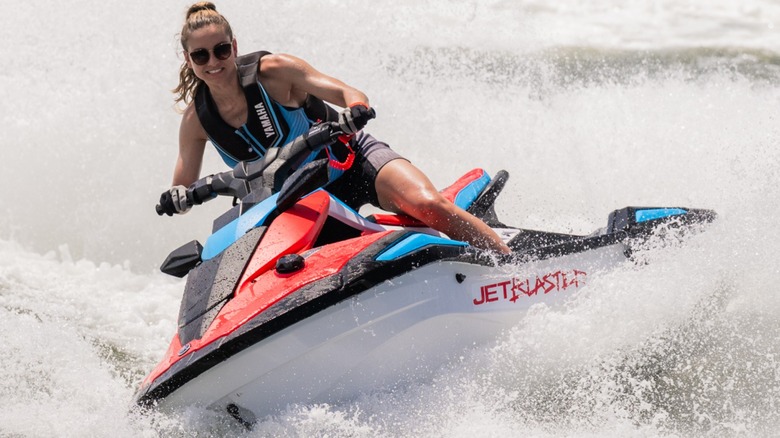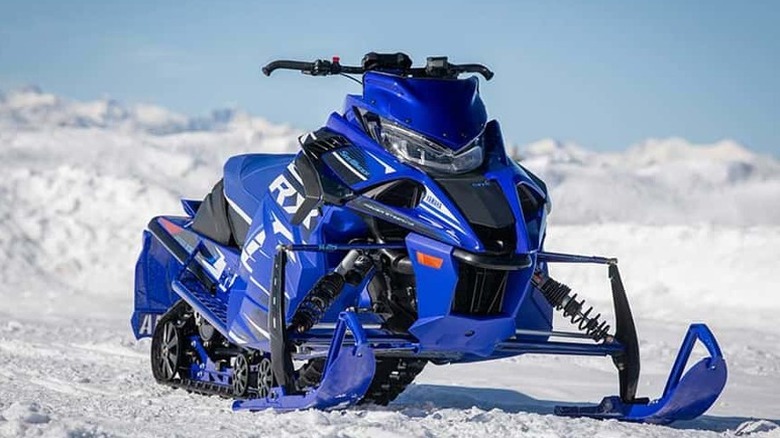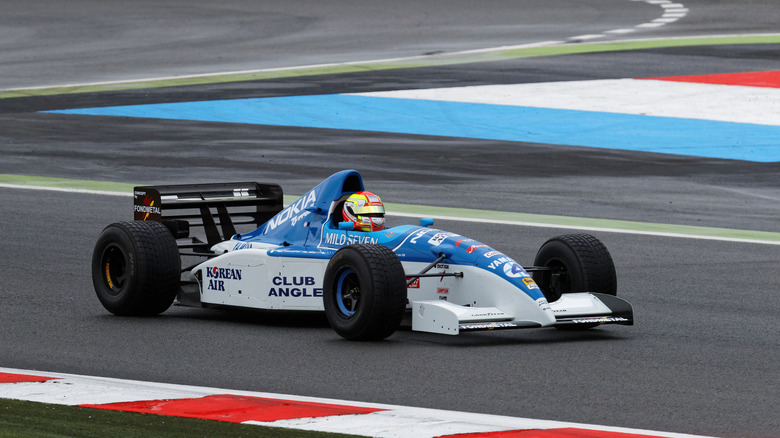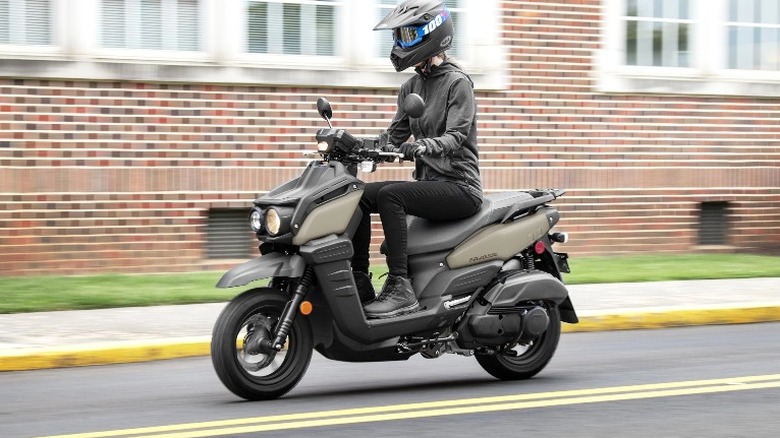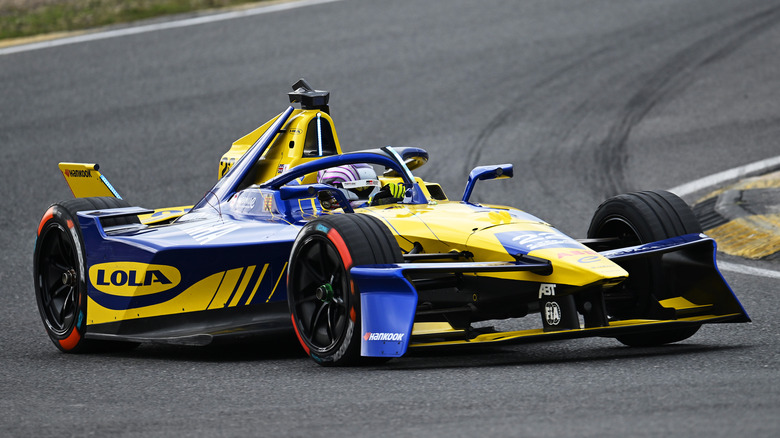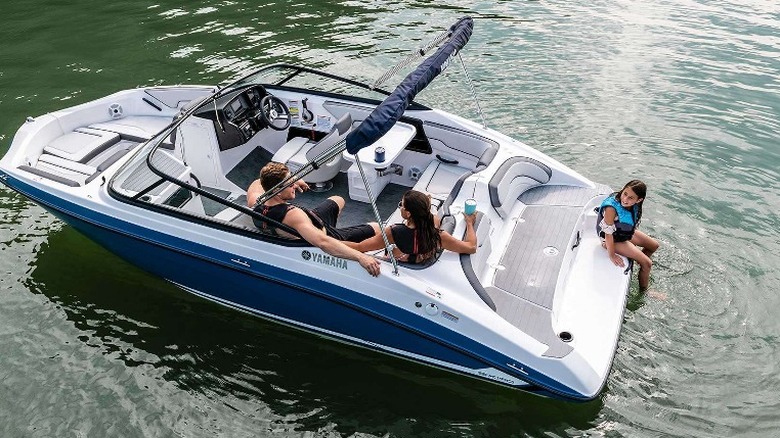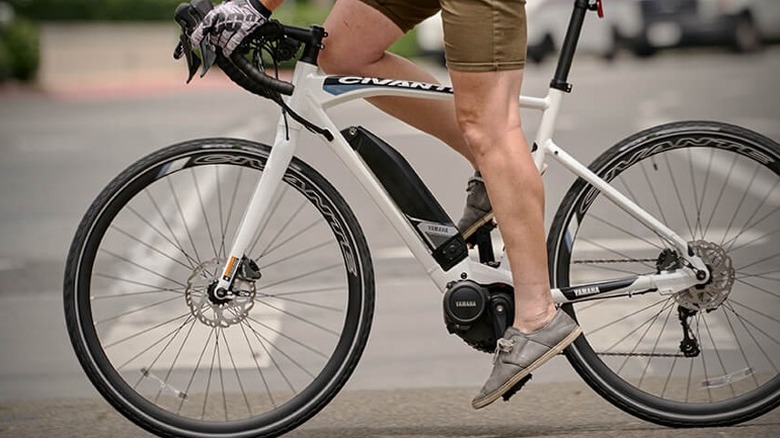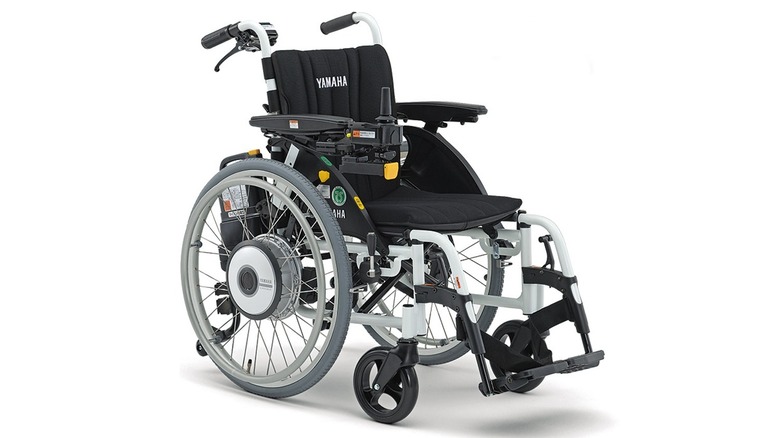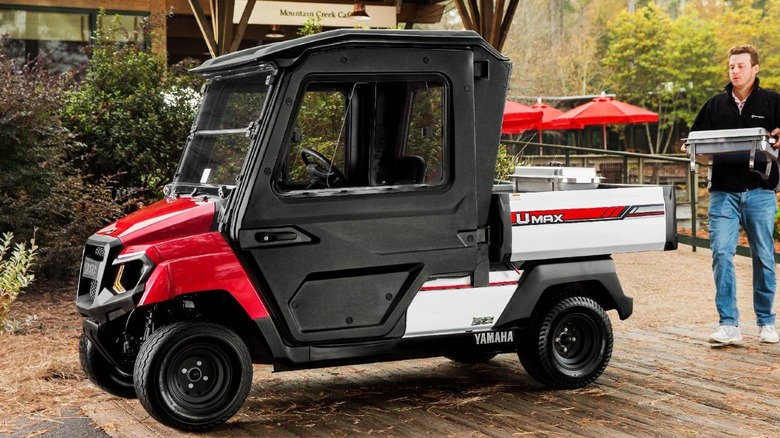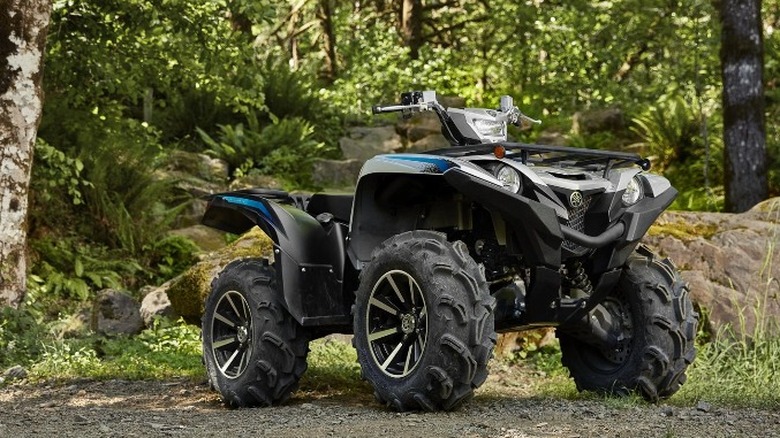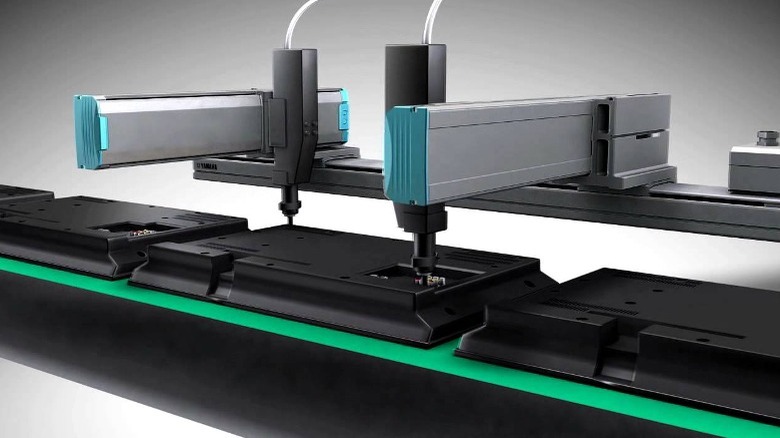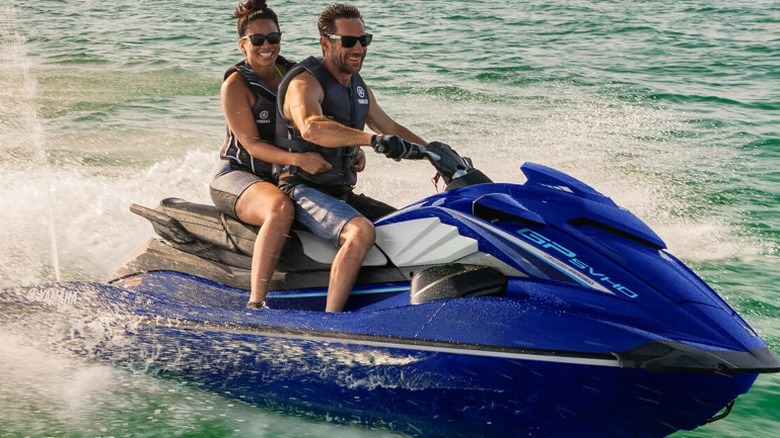11 Products Yamaha Makes Besides Motorcycles
Yamaha has a complicated history. For many, the name is synonymous with the brand of musical instruments and audio equipment. However, the Yamaha name is also closely associated with a series of motorcycles that have evolved over the years. That's because the Yamaha Motor Company was split off from Yamaha Corporation to be its own entity in the 1950s.
Since then, Yamaha has produced some of the best motorcycles ever made and established a reputation around the world for quality and reliability. In keeping with its diverse history, Yamaha Motor Company doesn't just make motorbikes. The brand actually has a wide range of products that you probably had no idea it makes, ranging from snowmobiles to industrial robots. These are some of the things Yamaha makes that might surprise you.
Snowmobiles
Snowmobiles might be one of the more obscure things that Yamaha makes — although it won't be doing so for much longer. The company has announced in 2023 that it is exiting the snowmobile market after decades of supplying snowmobiles to customers. That doesn't mean Yamaha is simply leaving with a whimper, with the brand instead producing several 2025 models that will act as a final farewell before it bows out, including a number of limited edition snowmobiles. Fortunately, anyone picking up a Yamaha snowmobile in the near future will retain standard warranties and service for a number of years.
Those who opt for one of the 2025 models can get a vehicle with final edition badging to mark that it is one of the last Yamaha snowmobiles. The likes of the SIDEWINDER SRX LE EPS and the SIDEWINDER L-TX LE EPS are on the more expensive side, costing around $20,000 each. These operate in all terrains, have electric power steering, and impressive front shock absorbers. If you are a beginner to snowmobiles, there's also some cheaper options available, such as the $9,000 SX Venom.
Formula 1 engines
Modern-day Formula 1 powertrains are complicated pieces of technology, and the new engine regulations for 2026 in F1 will make the sport more environmentally friendly. However, these powertrains are a far cry from the engines that propelled Formula 1 cars during the 1980s and 1990s. That was when powerful 3.5-liter naturally aspirated engines and Yamaha got in on the action for the first time in 1989.
Having operated as an engine supplier in the lower category Formula 2 competition, it isn't surprising that Yamaha entered Formula 1. After all, it is the pinnacle of motorsports and the ultimate aim for any company involved in motor racing. The company first entered a partnership with Zakspeed Formula Racing and found limited success with the original OX88 engine.
In subsequent years, Yamaha supplied engines to several teams, evolving its initial design into variants such as the OX99. Yamaha engines powered the Jordan, Arrows, and Tyrrell teams in the 1990s before exiting the sport in 1997. By then, the engine supplier had been involved in over 100 races and had a second-place finish at the Hungarian GP with Damon Hill behind the wheel.
Scooters
Considering that Yamaha is a brand most closely associated with motorcycles, it perhaps shouldn't be a huge shock that it also produces scooters. We aren't talking about electric scooters that have become popular years but rather motor scooters that are essentially a cousin of the motorcycle.
Yamaha offers two 2025 models of scooters: the Zuma 125 and the XMAX. The first of these is a lightweight, budget-friendly scooter that has a 125cc motor and weighs just 282 pounds. The Zuma 125 is a highly regarded fully automatic scooter that has been popular for decades and starts at a price of $3,799. Meanwhile, the XMAX is a more expensive scooter with a starting price of $6,199, but it features a liquid‑cooled 292cc engine, smartphone connectivity, and a 4.2-inch infotainment display.
Yamaha also offers a range of accessories for its scooter line-up. There are protective covers for the scooters to help shield them from bad weather, windshields to give riders some protection from the elements, and even storage cases that can be attached so users can carry more personal belongings with them.
Formula E powertrains
Although Yamaha had been previously involved in racing through Formula 1 and its junior categories, the company has not been involved in this type of motorsport since 1997. That is set to change at the end of 2024 when Yamaha and Lola Cars join together to create a powertrain for the ABT Formula E team for the competition's 11th season.
Yamaha Motor Company will act as a technical partner for Lola Cars, working with the company to develop, test, and manufacture engines for the successful ABT outfit. However, exactly how long this partnership will last is unclear. Lola Cars has confirmed its commitment to Formula E until 2030 with the introduction of the Gen4 ruleset, but Yamaha has yet to say whether it will be involved in the new era.
Yamaha director Heilji Maruyama told The Race about how being involved in Formula E would help the company research and develop new technology that focuses on sustainability. "As the technical partner, we hope to acquire more advanced energy management technologies through the highest level of electric racing in Formula E," Maruyama said.
Boats
Yamaha has been involved in designing and producing boats for more than six decades and the company describes itself as "dedicated to enhancing the boating experience, transforming each weekend into memories that last a lifetime." Unlike some of its other ventures, Yamaha actually has a larger number of motorized and jet boats available to purchase, with more than a dozen models for sale through its official website.
These include everything from 19 and 22-foot sport boats all the way up to the more expensive Yamaha Wake Series and the Yamaha Center Consoles range. Prices range from around $40,000 for the smaller 19-foot sport boats such as the SX190 or the AR190, although the cost jumps dramatically for the 27-foot models, such as the $165,000 275SD.
The company's center console boats are ideal for fishing and cost anywhere from $44,000 to $112,000 for the most advanced boats, while its wakesurfing range starts at $85,000. Through its "build" feature, Yamaha also allows customers to personalize boats. It is possible to add features and customize the look and feel of the boat through the various options available in terms of style and furnishings.
E-Bikes
E-bikes are becoming a more and more popular way for people to get around. These electric bicycles come equipped with batteries and motors to give riders a helping hand. You might not know, though, that Yamaha has not only been involved in the industry for some 30 years but was one of the pioneers behind the idea of an e-bike. Back in 1993, the Yamaha Motor Company developed its Power Assist System bicycle, which used an electric motor to provide assistance to the rider when it came to pedaling.
Since that time, Yamaha has remained as a manufacturer of e-bikes and has extended its range to cover all rider needs. For those who value fitness and want ultimate performance, the Crosscore series is a great option. Starting from $2,999, this bicycle is designed for use in urban areas. There's also the Wabash RT, which is intended for use on gravel roads, and the Civante — an e-bike that can reach up to 28 mph on roads. Finally, Yamaha also offers the YDX-Moro Pro for mountain biking.
All these bicycles feature Yamaha's power assist technology. This automatically detects the level of effort the rider is giving and the speed of the bike to provide an ideal amount of additional pedaling force through the motor. This can be adjusted to provide even more help for trickier areas, such as hills.
Wheelchairs
The Japanese-based company also has its own series of motorized wheelchairs as part of the Yamaha Motor Land Mobility initiative. The Joy Wheel series of wheelchairs are intended to offer a good compromise between the lightweight and compact nature of manual wheelchairs with the power and mobility of motorized models.
To fulfill this mission, Yamaha offers two distinct types of wheelchairs. The first is the electric powered JW Active Plus+. Like most manual wheelchairs, this model can be folded down into a small size for easy transportation but is a fully electric wheelchair that features a motor and clutch that can be controlled with a joystick.
On the other hand, assist-based JW Swing is designed to provide extra assistance in turning the wheels of the device. It uses the same Power Assist System technology that Yamaha utilizes in its e-bikes, meaning the sensors detect how much torque is being provided by the user and supplements this with the right amount of additional power.
Golf carts
Anyone who has ever seen a golf cart in television shows and movies probably doesn't actually know all that much about them. They are simply a convenient way to move around a golf course without carrying around your clubs. Yet, for those in the know, a good golf cart is an important piece of equipment and Yamaha has been a major player in the market for some time now. In fact, Yamaha is trusted as a reliable and high-quality choice among golfers as it produces durable models that don't often break down.
Yamaha promises those who pick its golf carts the "most comfortable and luxurious ride" thanks to its wide seats and large storage space. The company also offers both gas and electric models, so you can choose to be more environmentally conscious. It includes Independent Rear Suspension on all of its models. The range includes the Drive 2, the UMAX Two for higher storage needs, and the longer Concierge 6 for larger parties. Personalization options are also available, from individual number plates to coolers that can be attached to the side of the carts.
All terrain vehicles
As part of its motorsports lineup, Yamaha also sells a collection of all-terrain vehicles. In fact, Yamaha has a range of cool-looking ATVs that can rival any other manufacturer in the market, including its closest competitor, Honda. The company began producing ATVs way back in the 1970s with the release of the Tri-Moto YT125 and has continually produced three and four-wheel models since then. Yamaha has now produced dozens of different ATVs with sleek designs that help them stand out from the crowd.
Among the 18 2025 ATV models that Yamaha offers, there's a wide variety in terms of price and features. For example, the YFZ50 and RAPTOR 110 are more stripped-down options that are intended for first-time users and are priced between $2,300 and $3,600. For more experienced riders who want great performance, there's the likes of the RAPTOR 700R SE and the YFZ450R SE, both of which cost in excess of $10,000.
In terms of utility ATVs that aren't designed for sport, Yamaha has the Grizzly and Kodiak ranges. The top models in each series are equipped with a 686cc engine and the brand's Ultramatic transmission. However, the GRIZZLY EPS XT-R also features an On-Command four-wheel drive and is designed for difficult and rugged terrains.
Industrial Robots
Yamaha doesn't just produce vehicles and other forms of transportation. The company also had its hand in the industrial robot market, designing and making robots that are intended to be the manufacturing process of other products. Some of the industrial robots that Yamaha offers include single-axis robots and something known as a Linear Conveyor Module. These are intended to help transport parts and objects during manufacturing using conveyor belts and treads.
Other models also include SCARA and Cartesian robots, which are used to pick, place, and manipulate parts quickly and accurately. They can be programmed to carry out a variety of tasks, with the Cartesian robots able to move in three dimensions. This makes it extra useful for processes such as 3D printing and laser cutting. Another type of robot that Yamaha produces is a robot vision system, which utilizes technology to see and identify objects using cameras and software to interpret surroundings.
WaveRunners
There's a good chance you might not have heard the term "WaveRunner," as it is common for personal watercraft like Yamaha's range to simply be known as jet skis. Yamaha has been producing its own version of the jet ski since 1986, with the launch of the WaveRunner 500. This product set a new standard for small personal watercraft and the company subsequently launched dozens of variants over the next four decades.
Now, Yamaha has a range of five different series of WaveRunners, ranging from high-performance supercharged jet skis to the luxury-focused FX series. There are 21 distinct WaveRunners available from Yamaha, with prices starting at as little as $7,999 for the standard Jetblaster and up to more than $20,000 for the FX Cruiser SVHO. Yamaha also has some WaveRunners that are intended for high-speed racing, such as the GP SVHO. Starting from $17,000, this WaveRunner can reach a top speed of around 67 mph.
